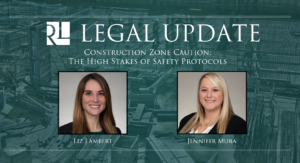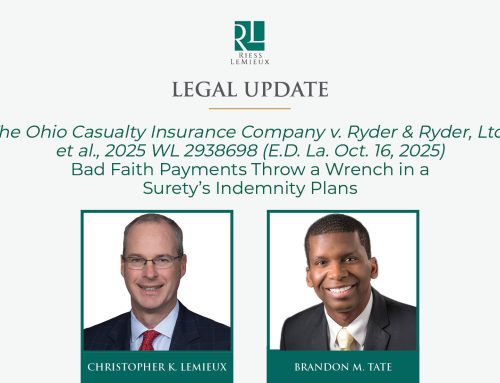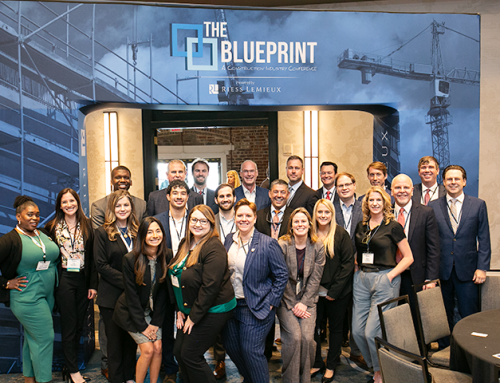 Barber Bros. Contracting Co. v. Capitol City Produce Co., 2023-C-00788, 2024 WL 3218636 (La. June 28, 2024).
Barber Bros. Contracting Co. v. Capitol City Produce Co., 2023-C-00788, 2024 WL 3218636 (La. June 28, 2024).
Authors – Liz Lambert and Jennifer Mura
Construction Zone Caution: The High Stakes of Safety Protocols – Lessons from Barber Brothers v. Capitol City Produce on Roadwork Construction Safety and Liability.
In March 2018, Barber Brothers was performing road construction and asphalt concrete leveling on the I-10 exits for LA-3188 near the “three-mile bridge” in Laplace, Louisiana. The project required the temporary closure of exits and working at night to minimize public inconvenience. La DOTD designed a temporary traffic control plan that required Barber Brothers to remove the reflective warning cones that were placed across the closed exits at the end of the night. The Standard Procedure for the cone removal was that a Barber Brothers’ truck would back up along the shoulder of the roadway while a worker on foot moved the cones off the road. On March 27, 2018, at 5:37 a.m. during the removal of the traffic cones, the plaintiff was driving a Capitol City Produce box truck in the right lane and collided with the backing Barber Brothers’ truck, resulting in severe injuries.
At the time of the incident, the taillights, brake lights, and reverse lights were functioning on the Barber Brothers’ truck, and the worker was wearing a reflective safety suit. However, the right shoulder of the roadway narrowed significantly on the bridge causing the Barber Brothers’ truck to partially cross over the line into the right travel lane that the plaintiff was traveling in.
Following a trial, the jury found Barber Brothers 100% at fault for the accident and awarded the Plaintiff and his family significant damages, totaling $13,446,634.65. Barber Brothers appealed the judgment and the First Circuit Court of Appeal, in a split decision, affirmed. The appellate court found no error in the trial court’s jury instructions or in the jury’s conclusion that the Plaintiff, the forward-moving driver, was not at fault.
The Louisiana Supreme Court reviewed the lower court’ rulings and made several critical findings. First, the Supreme Court addressed the exclusion of certain jury instructions. The Court agreed with the trial court and the court of appeals’ interpretation that La. R.S. 32:125 which requires drivers to slow down and move to the left when encountering vehicles with warning lights, applies only to “parked” vehicles and not trucks backing at 1 mph, as the Barber Brothers’ truck. Similarly, the Supreme Court found that the trial court also erred by not charging the jury on the heightened standard of care for a CDL driver approaching a highway construction zone.
Ultimately, the Court found the exclusion of the jury instructions was not a reversible error and did not sufficiently prejudice Barber Brothers’ defense. The Court concluded the jury instructions as a whole covered the necessary duties of a motorist under Louisiana law, including maintaining proper speed and control of his vehicle, maintaining a proper lookout, observing what should be seen in the exercise of due diligence, and obeying warning signs and signals placed on the road under construction.
However, the Supreme Court found the jury’s failure to assign any fault to the Plaintiff was unreasonable and manifestly erroneous. The Court acknowledged that Barber Brothers bore the majority of fault for not adhering to the DOTD traffic control plan by not staying on the right shoulder while backing. Although the Barber Brothers’ truck was, at most, 18 inches into the right lane at the time of the incident, had the truck remained completely on the shoulder, it is more likely than not that the accident would not have occurred. On the other hand, the Court also found that the evidence indicated plaintiff failed to maintain a proper lookout and he should have seen the Barber Brothers’ truck or the DOTD warning signs and taken evasive action. The Court reallocated fault, assigning 80% to Barber Brothers and 20% to the Plaintiff. The Court then reduced Plaintiff’s general damages to $5,000,000 and the loss of consortium damages to $600,000.
The Barber Brothers decision underscores the critical importance for construction companies and motorists to strictly adhere to traffic regulations, traffic control, and safety plans. Deviations from traffic laws or approved safety protocols, even minor ones (i.e. only deviating 18 inches), can result in significant liability. This decision emphasizes that contractors working on road construction projects owe a heightened duty of care to motorists and further highlights the necessity of ensuring all safety measures, including proper lighting, clear signage, and reflective materials, are consistently implemented and followed. By fostering a culture of safety and staying informed about legal responsibilities, construction companies can protect both workers and the public by reducing the potential for accidents as well as the associated legal and financial consequences.



